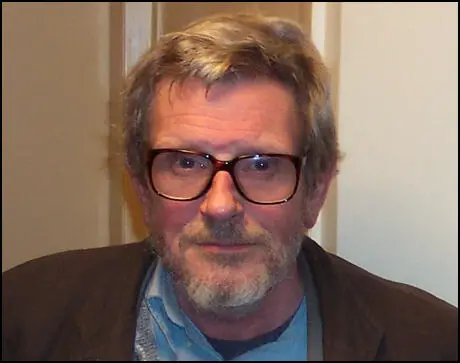On this day on 10th June
On this day in 1924 fascists kidnap and kill Italian Socialist leader Giacomo Matteotti. Matteotti was born in Italy in 1885. Matteotti, the leader of the United Socialist Party in the Chamber of Deputies, led the campaign against Benito Mussolini and his Fascist Party.
On 10th June 1924, Matteotti disappeared from Rome. His body was found in a shallow grave three days later. Matteotti's death provoked anti-fascist demonstrations but King Victor Emmanuel III refused to sack Benito Mussolini and reintroduce democracy.
On this day in 1935 Chips Channon writes in his diary about Prince of Wales and Wallis Simpson and Adolf Hitler. "Much gossip about the Prince of Wales' alleged Nazi leanings; he is alleged to have been influenced by Emerald Cunard (who is rather eprise with Herr Ribbentrop) through Mrs Simpson. The Coopers are furious, being fanatically pro-French and anti-German. He has just made an extraordinary speech to the British Legion advocating friendship with Germany; it is only a gesture, but a gesture that may be taken seriously in Germany and elsewhere. If only the Chancelleries of Europe knew that his speech was the result of Emerald Cunard's intrigues, themselves inspired by Herr Ribbentrop's dimple!"
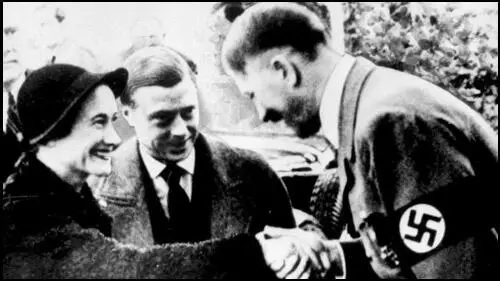
On this day in 1940 the leader of the Universal Negro Improvement Association (UNIA), Marcus Garvey died. Garvey arrived in the United States on 23rd March 1916 and immediately launched a year-long tour of the country. He organized the first branch of UNIA in June 1917 and began published the Negro World, a journal that promoted his African nationalist ideas. Garvey's organization was extremely popular and by 1919 UNIA had 30 branches and over 2 million members.
Like the National Association for the Advancement of Coloured People (NAACP) Garvey campaigned against lynching, Jim Crow laws, denial of black voting rights and racial discrimination. Where UNIA differed from other civil rights organizations was on how the problem could be solved. Garvey doubted whether whites in the United States would ever agree to African Americans being treated as equals and argued for segregation rather than integration. Garvey suggested that African Americans should go and live in Africa. He wrote that he believed "in the principle of Europe for the Europeans, and Asia for the Asiatics" and "Africa for the Africans at home and abroad".
Garvey began to sign up recruits who were willing to travel to Africa and "clear out the white invaders". He formed an army, equipping them with uniforms and weapons. Garvey appealed to the new militant feelings of black that followed the end of the First World War and asked those African Americans who had been willing to fight for democracy in Europe to now join his army to fight for equal rights.
In 1919 Garvey formed the Black Cross Navigation and Trading Company. With $10,000,000 invested by his supporters Garvey purchased two steamships, Shadyside and Kanawha, to take African Americans to Africa. At a UNIA conference in August, 1920, Garvey was elected provisional president of Africa. He also had talks with the Ku Klux Klan about his plans to repatriate African Americans and published the first volume of Philosophy and Opinions of Marcus Garvey.
After making a couple of journeys to Africa the Black Cross Navigation and Trading Company ran out of money. Garvey was a poor businessman and although he was probably honest himself, several people in his company had been involved in corruption. Garvey was arrested and charged with fraud and in 1925 was sentenced to five years imprisonment. He had served half of his sentence when President Calvin Coolidge commuted the rest of his prison term and had him deported to Jamaica.
In 1928 Garvey went on a lecture tour of Britain, France, Belgium, Switzerland and Canada. On Garvey's return to Jamaica he established the People's Political Party and a new daily newspaper, The Blackman. The following year Garvey was defeated in the general election for a seat in Jamaica's colonial legislature.
In July, 1932, Garvey began publishing the evening newspaper, The New Jamaican. The venture was unsuccessful and the printing presses were seized for debts in 1933. He followed this with a monthly magazine, Black Man. He also launched an organization that he hoped would raise money to help create job opportunities for the rural poor in Jamaica.
The project was not a success and in March, 1935, Garvey moved to England where he published The Tragedy of White Injustice. Marcus Garvey continued to hold UNIA conventions and to tour the world making speeches on civil rights until his death in London. tears".
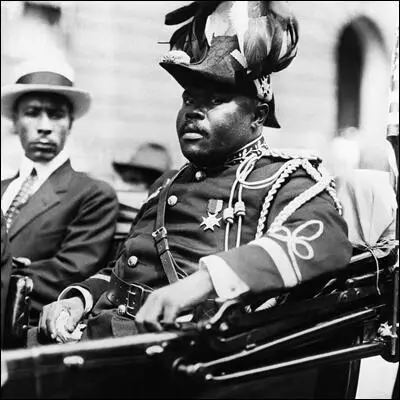
On this day in 1941 British intelligence warn Joseph Stalin that Adolf Hitler is about to invade the Soviet Union. In 1939 Leopold Trepper, an agent for the NKVD, established the Red Orchestra network and organised underground operations in several countries. Richard Sorge was one of its key agents. Others in the group included Ursula Beurton, Harro Schulze-Boysen, Libertas Schulze-Boysen, Arvid Harnack, Mildred Harnack, Sandor Rado, Adam Kuckhoff and Greta Kuckhoff. Arvid Harnack, who worked in the Ministry of Economics, had access to information about Hitler's war plans, and became an important spy. Harnack had a close relationship with Donald Heath, the First Secretary at the US Embassy in Berlin.
On 18th December, 1940, Adolf Hitler signed Directive Number 21, better known as Operation Barbarossa. It included the following: "The German Wehrmacht must be prepared to crush Soviet Russia in a quick campaign even before the conclusion of the war against England. For this purpose the Army will have to employ all available units, with the reservation that the occupied territories must be secured against surprises. For the Luftwaffe it will be a matter of releasing such strong forces for the eastern campaign in support of the Army that a quick completion of the ground operations can be counted on and that damage to eastern German territory by enemy air attacks will be as slight as possible. This concentration of the main effort in the East is limited by the requirement that the entire combat and armament area dominated by us must remain adequately protected against enemy air attacks and that the offensive operations against England, particularly against her supply lines, must not be permitted to break down. The main effort of the Navy will remain unequivocally directed against England even during an eastern campaign. I shall order the concentration against Soviet Russia possibly 8 weeks before the intended beginning of operations. Preparations requiring more time to get under way are to be started now - if this has not yet been done - and are to be completed by May 15, 1941."
Within days Richard Sorge sent a copy of this directive to the NKVD headquarters. Over the next few weeks the NKVD received updates on German preparations. At the beginning of 1941, Harro Schulze-Boysen, sent the NKVD precise information on the operation being planned, including bombing targets and the number of troops involved. In early May, 1941, Leopold Trepper gave the revised date of 21st June for the start of the Operation Barbarossa. On 12th May, Sorge warned Moscow that 150 German divisions were massed along the frontier. Three days later Sorge and Schulze-Boysen confirmed that 21st June would be the date of the invasion of the Soviet Union.
In early June, 1941, Friedrich-Werner Graf von der Schulenburg, the German ambassador, held a meeting in Moscow with Vladimir Dekanozov, the Soviet ambassador in Berlin, and warned him that Hitler was planning to give orders to invade the Soviet Union. Dekanozov, astonished at such a revelation, immediately suspected a trick. When Stalin was told the news he told the Politburo it was all part of a plot by Winston Churchill to start a war between the Soviet Union and Germany: "Disinformation has now reached ambassadorial level!"
On 16th June, 1941, an agent cabled NKVD headquarters that intelligence from the networks indicated that "all of the military training by Germany in preparation for its attack on the Soviet Union is complete, and the strike may be expected at any time.". Later Soviet historians counted over a hundred intelligence warnings of preparations for the German attack forwarded to Stalin between 1st January and 21st June. Others came from military intelligence. Stalin's response to an NKVD report from Schulze-Boysen was "this is not from a source but a disinformer."
Sam E. Woods, commercial attaché in Berlin, developed excellent contacts in the German army command - contacts which brought him close to high-ranking German staff officers opposed to Hitler who knew of the plans for Operation Barbarossa. Woods was able to follow the German preparations from July 1940 until the plans were finalized that December. President Franklin D. Roosevelt and Secretary of State Cordell Hull, agreed that Moscow should be told. Roosevelt ordered, Undersecretary of State Sumner Welles met on 20th March, 1940 with the Soviet Ambassador to Washington, Konstantin A. Umansky, to pass along a warning.
In September 1940, U.S. Army cryptanalysts solved the Japanese diplomatic cipher. Most of the material covered Japanese interests in Asia and the Pacific, but in the last week of March 1941 the cryptanalysts began to produce clear indications of a German invasion. Washington now knew enough about the impending invasion to be very concerned. To reinforce the warning already given to the Soviet ambassador, Welles passed a similar notice through our ambassador in Moscow, who on 15th April, 1941, told a contact in the Foreign Ministry about the plans for Operation Barbarossa.
Winston Churchill sent a personal message to Stalin in April, 1941, explaining how German troop movements suggested that they were about to attack the Soviet Union. However, Stalin was still suspicious of the British and thought that Churchill was trying to trick him into declaring war on Germany. Christopher Andrew points out that he believed this information from Churchill was part of a British political conspiracy: "Churchill's personal warnings to Stalin... only heightened his suspicions... Behind many of the reports of impending German attack Stalin claimed to detect a disinformation campaign by Churchill designed to continue the long-standing British plot to embroil him with Hitler."
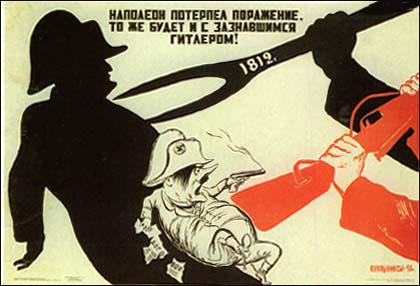
On this day in 1944 SS carry out a revenge attack on the Maquis at Oradour-sur-Glane. In the spring of 1942, communist militants, acting independently of the leadership of the French Communist Party, organized the first Maquis in the Limousin and the Puy-de-Dôme. Marquis groups were established in other regions of France. As the Maquis grew in strength it began to organize attacks on German forces.
In the Limousin, the Marquis were led by the Communist militant, Georges Guingouin. At this time Guingouin was not supplied with any weapons. Therefore their main method of resisting the German Army was sabotage. This included attacks on bridges, telephone lines and railway tracks.
The Maquis also provided aid and protection to refugees, immigrants, Jews, and others threatened by the Vichy and the German authorities. They also helped to get Allied airman, whose aircraft had been shot down in France, to get back to Britain.
In March 1944, the German Army began a campaign of repression throughout France. This included a policy of reprisals against civilians living in towns and villages close to the scene of attacks carried out by members of the French Resistance. As one official wrote on 15th April, 1944 that the authorities "wanted to strike fear into the population and change their opinion by showing them that the evils they were suffering were the direct consequence of the existence of the marquis and that they had made the mistake of tolerating them."
On 5th June, 1944, General Dwight D. Eisenhower asked the BBC sent out coded messages to the resistance asking them to carry out acts of resistance during the D-day landings in order to help Allied forces establish a beachhead on the Normandy coast. The Maquis responded to this request and on 7th June, a unit attacked the German garrison at Tulle. The following day the arrival of reinforcements forced the unit to withdraw. The German losses were considerable, it was reported that 37 soldiers were killed and another 25 were wounded.
On the 9th June, the Schutzstaffel (SS) hanged 99 men from the balconies, trees, and bridges along the main street of Tulle. Another 149 were deported to Germany. Later that day another 67 were murdered in Argenton. The following day German soldiers began encircling the village of Oradour-sur-Glane. A unit of 120 soldiers from the Waffen SS tank division entered the village and instructed everyone to assemble in the central marketplace. Other soldiers in armored cars rounded up men and women working in nearby farms and fields.
At about three o'clock the soldiers separated the women and children from the men. They were taken to the church and locked in. Major Otto Dickman, announced that the SS knew that the village was hiding arms and munitions for the French Resistance. Dickman then told the mayor, Paul Desourteaux, to select hostages from among those assembled in the marketplace. The mayor refused, offering himself and his sons instead.
Dickman rejected Desourteaux's offer and ordered that all the men be divided into groups and moved them to various barns and garages in the village. The SS soldiers then opened fire on the men. The only ones to survive were five young men from a group of 62 taken to the Laudy barn. This included Marcel Darthout: "We felt the bullets, which brought me down. Everyone was on top of me. And they were still firing. And there was shouting. And crying. I had a friend who was lying on top of me and who was moaning. And then it was over. No more shots. And they came at us, stepping on us. And with a rifle they finished us off. They finished off the buddy who was on top of me. I felt it when he died."
At five o'clock two German soldiers entered the church and placed a large chest on the altar. They walked out, laying out a long fuse as they went, which they lit before shutting the door. A few seconds later the chest exploded. Some managed to survive the blast but were shot dead by the soldiers as they scrambled out of the bombed building. Only Marguerite Rouffanche managed to get out of the church and escape the bullets being fired by the SS soldiers. Although she was wounded she managed to hide until the Germans left the village.
Sarah Farmer, the author of Martyred Village (1999) later explained: "Only one person managed to save herself from the conflagration. Marguerite Rouffanche, a forty-seven-year-old woman, had been part of a group that pushed back into the sacristy in search of fresh air. As the church burned, she crawled behind the altar and found a stool used for lighting candles. She managed to climb up and out the window. She dropped three meters to the ground below. Looking up, Madame Rouffanche saw that she had been followed by a young woman with a baby. The young woman handed down her baby before jumping, but all three were caught in a hail of machine-gun fire. Mother and child were killed; wounded, Madame Rouffanche was able to crawl into the garden of the presbytery, where she hid among rows of peas."
The Germans then destroyed Oradour-sur-Glane. A total of 642 people were killed during the SS operation. This included 393 people living in the village, 167 people from neighbouring villages, 33 people from Limoges, and 25 others from different parts of the Haute-Vienne. Around 80 residents of Oradour survived. This included the five men from the Laudy barn, Marguerite Rouffanche from the church, 28 people who managed to hide during the roundup and 36 others who happened to be away for the day. Another 12 men were in Germany as part of Vichy's compulsory labour service.
Local hamlets also suffered high losses. Eight children of Le Mas du Puy attended the school at Oradour. Four mothers, concerned that their children had not come home from school, had gone to Oradour to look for them. They died with their children in the church.
In 1946 the French government decided to preserve the ruins of Oradour-sur-Glane. The forty acres of crumbling buildings became a martyred village. A testament of French suffering under the German occupation and an example of Nazi barbarism.
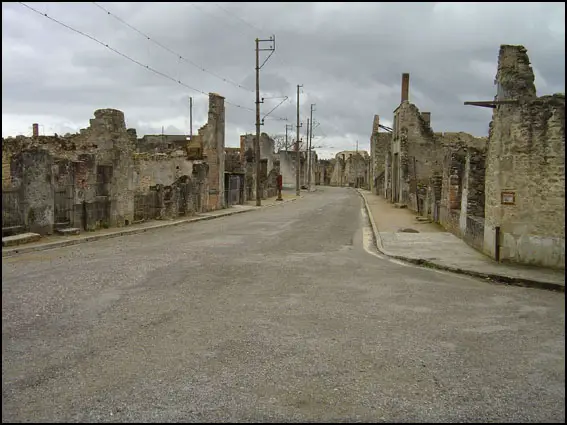
On this day in 2008 Bernard Crick writes about the death of historian Angus Calder
Angus Calder, who has died aged 66 from lung cancer, was an extraordinarily versatile writer - historian, poet and essayist - and a stirring figure on the Scottish scene. He gained prominence with the publication, in 1969, of his first book, The People's War: Britain 1939-1945. A pioneering study of the home front, dispassionate and, at times, ironic when modifying the lingering myths of wartime propaganda, it won the John Llewellyn Rees prize and has remained in print ever since.
Not until 1981 did another major work appear, Revolutionary Empire, a deeply researched account of British imperial expansion that was no-holds-barred tendentious, as was The Myth of the Blitz (1992). Yet both Calder's zeal for wide reading and his way of life worked against the production of more major books, though, in 2004, he produced two fascinating late collections of black humour, Gods, Mongrels and Demons: 101 Brief But Essential Lives and Disasters and Heroes: On War, Memory and Representation. Instead, his breadth of knowledge and intense, if spasmodic, concentration encouraged his positive mastery of the essay.
The drink had led to the break-up of his marriage in 1982. However, in and out of recurrent bouts of drinking followed by spasmodic abstinence, a remarkable number of fine essays appeared. When one thought he was out for the count, he was up again and into print. He edited notable selections of Hugh MacDiarmid, Walter Scott, 19th-century Russian fiction, the poems of Burns and of Robert Louis Stevenson, and, with Paul Addison, Time to Kill: The Soldier's Experience of the War in the West 1939-45. He published verse throughout his life, winning the Eric Gregory Award for poetry in 1967, but brought out his first volume of poems, Waking in Waikato, in 1995. He was co-editor of the Journal of Commonwealth Literature from 1981 to 1987.
